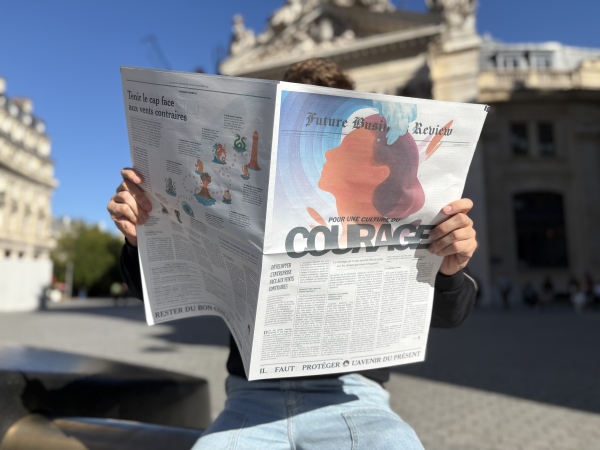Keep a cool head. Don't give in to collective incantations. Cultivate coherence and a clear direction. It seems that the exercise of corporate governance today resembles an act of introspection, or even resistance. In an uncertain environment with a completely muddled economic, political, and geopolitical agenda, leaders suffer from decisional solitude. In these difficult situations, a wise path consists of drawing on the company's cultural coherence. The case of mutualist companies provides a powerful example.
Leadership fully manifests in the ability to keep a cool head in a crisis. Yet, in such situations, leaders can be influenced by their environment, by an atmosphere, and by its buzzwords of the moment and its organizational trends.
Psychoanalysts know well that giving a name to an anxiety provides the power to better control it—or at least, the feeling of control—at the risk of turning away from its true origin. "What does the bottle matter, so long as one has the drunkenness," as the proverb goes. It is therefore not uncommon to see decision-makers rush into a new method as soon as it seems to promise to rally people around—if not resolve—the difficulties of the moment. In reality, this is a fog-of-war effect that can be blinding.
Mutualism Was Resilient Before the Word Even Existed
In contrast to this overreaction to crisis, there are models that draw their resources and renewal from within themselves. The mutualist model represents a useful and highly relevant example of steering through turbulence. Although often perceived as going against the grain of dominant trends, it proves to be concretely high-performing and very resilient. Its effectiveness lies in its ability not to yield to the injunctions of the moment, but rather to draw the levers of its action from its deep roots and its century-old identity.
Mutualism is poorly understood and often little-known. Yet, it is actually in sync with the aspirations of today's public. Its intrinsic characteristics distinguish it favorably from conventional business models.
Through a unique—but often poorly known—narrative, it fosters a very strong dynamic of affinity-based engagement from its members and employees. Where many companies struggle to establish a relationship of trust with their audiences, mutualism builds solid bonds based on a common experience and culture.
Its governance is distributed and highly effective. A system of consultation and participation in decisions offers members information and decision-making power over the company's direction. Even if participation varies, the mere idea of being able to vote generates a relationship of trust. This has particular resonance in the French context of distrust towards institutions.
Mutualism is natively ESG/CSR, without needing to proclaim it with this or that label. It stands apart from companies suffering from the "incantation" of certifications or regulatory difficulties, such as Benefit Corporations, for example.
It embodies a natively contributory economy at the local level. This reality contrasts with the quest to apply regenerative models, which are very promising and forward-looking but still recent in their application.
Mutualist entities offer a concrete, local democratic experience, which contrasts with the risk of bureaucratization in the public sector or the disconnect of shareholders in the private sector, both of which can weaken most representative, joint, or public interest models.
Finally, mutualism generates engagement and pride among its employees and stakeholders, whereas conventional models (private and public) are confronted with disengagement and turnover.
Close to what Léon Bourgeois called the "Third Way," situated between shareholder capitalism and public systems, mutualism thus constitutes an effective form—what we would today call resilient and robust. The case of Groupamaillustrates this path well. The culture of utility and its history carried weight when the question of the company's "remutualization" arose.
This intangible heritage played a key role after the decision not to fully enter the listed market. This desire, which went against the current of many French banking and insurance players at the time, allowed for a redefinition of the organization to ensure the company's longevity and guarantee its utility to members and the quality of its services. Today, the company's performance, in both its social and economic models, is fully recognized.
Groupama, a European Singularity
The Groupama experience highlights several aspects of mutualism today:
- Identifying the company's uniqueness: Groupama's uniqueness was identified and cultivated as an intangible asset. This culture is centered on solid relational systems (a community of elected representatives, local and regional bodies, monitoring of the quality of connection and engagement), a distinctive narrative, and a unique type of organization (the company benefits from the largest volunteer community for a commercial brand). This echoes the affinity-based engagement and distributed governance that are the historical pillars of the mutualist model.
- The company assumes its role as a cultural actor because, through its business activities, it acts upon the nature of relationships between people, their aspirations, their rhythms and lifestyles, as well as their confidence in the future. These elements constitute real assets for the company and allow it to cultivate a differentiation beyond its initial business of insurance—which is otherwise highly standardized by regulation.
How to Be a Mutualist When You're Not One
Mutualism can be considered today as an inspiring model that clearly re-examines the question of a company's purpose, the definition of its value, and the nature of its relationships with stakeholders. Therefore, any organization would be well-advised to ask itself three foundational questions.
First, the question of the balance of its governance with regard to the people and entities factually involved in the company's activity. Second, the question of redefining its timescale and its geographical scope of impact. Finally, its narrative capacity, as a cultural actor rooted in a territory. There is thus a "mutualist resonance" in sectors that are unaware of it.
Let's simply take the example of luxury houses, which, well beyond their core business, have successfully worked on the symbolic and relational value of their activity with all their audiences. They thus borrow from mutualists, perhaps unwittingly, the idea that customers are more like convinced and involved patrons in the promotion of a certain conception of life, in a market where an "economy of consideration" is emerging.




